- IELTS Scores
- Life Skills Test
- Find a Test Centre
- Alternatives to IELTS
- All Lessons
- General Training
- IELTS Tests
- Academic Word List
- Topic Vocabulary
- Collocation
- Phrasal Verbs
- Writing eBooks
- Reading eBook
- All eBooks & Courses
- IELTS Writing Task 2
- Coherence and Cohesion

Improve Coherence and Cohesion in IELTS Writing Task 2
Coherence and cohesion in IELTS writing is essential if you want to elevate your essays but many candidates fall into the trap of overcomplicating their essays by using complex linking words and unnecessarily twisted sentence structures.
This guide will show you how to improve the flow and clarity of your essay using simple but effective techniques.
Understanding Coherence and Cohesion
In the IELTS Writing test, cohesion refers to how well your ideas link together, while coherence is how clear and logical your argument is. These two criteria account for 25% of your writing score. Mastering them doesn't require fancy vocabulary or complicated sentences; instead, it’s about making your ideas flow smoothly from one point to the next.
At the end of the day, ensuring the examiner understands what you’re saying is more important than the amount of complex sentence structures you manage to work into your answers.
How to Improve Cohesion
Use linking words sparingly and effectively.
Linking words are important, but too many can make your writing feel forced. Instead, use them when needed to guide the reader from one idea to another. Some of the most useful (and simple) linking words include:
- For adding information: "Moreover," "Also," "In addition"
- For contrasting ideas: "However," "On the other hand," "In contrast"
- For giving examples: "For example," "For instance," "such as"
- For concluding: "In conclusion," "To sum up," "Overall"
Here you will find a list of more common transition words .
Tip: Avoid using too many complex linking words like "Notwithstanding" or "Nevertheless" unless you’re fully confident in their usage. Simple words often do the job more effectively.
Important note:
Overusing simplistic transition words can make your writing look mechanical and limit your Coherence and Cohesion score to band 6. So it's about getting the right balance for your level and the band you need. We have a useful video explaining how to manage cohesive words and phrases for a band 7 and up.
Use Pronouns and Synonyms for Cohesion
Pronouns and synonyms help to avoid repetition and make your writing more cohesive. For example:
- Instead of repeating " The government " multiple times, you could alternate with the pronoun " It " or " This institution ."
- Use synonyms to vary your language. If you mention " global warming " later you can refer to it as " climate change ."
Tip: Ensure that the synonyms you use are accurate and don’t change the meaning.
Use Demonstratives
Demonstratives are this, that, these , and those . They are again a great way to improve coherence and cohesion in IELTS writing as you can refer back to what has been said without repeating everything again.
- People spend hours of their time online, chatting and in forums. Although this can be beneficial, it is certainly not the same as real interaction with human beings.
- The repatriation of historical objects and artefacts to their countries of origin has sparked intense debates. In my opinion, these items should be returned.
Note: It should always be clear what the demonstrative is referring back to.
How to Improve Coherence
Structure your essay clearly.
A well-structured essay makes it easier for the reader to follow your argument. Follow the basic IELTS essay structure:
- Introduction: Paraphrase the question and introduce your main points/opinion.
- Body Paragraph 1: Introduce your first point(s), provide an explanation, and support it with examples.
- Body Paragraph 2: Introduce your second point(s), provide an explanation, and support it with examples.
- Conclusion: Summarise your key points and restate your position.
Tip: Keep each paragraph focused on one main idea. Avoid squeezing too many points into a single paragraph, as this can confuse the reader.
Use Topic Sentences
This is something a lot of candidates actually forget to do once they start writing and get caught up in their own rambling. Each body paragraph should begin with a topic sentence that introduces the main idea of the paragraph. This helps the reader understand what to expect and improves coherence. For example:
- Bad topic sentence: “Many people think that climate change is an issue.”
- Good topic sentence: “One of the key reasons for climate change is the excessive burning of fossil fuels.”
Tip: Always follow your topic sentence with supporting information and examples.
Stick to Your Level
It’s common to think that using lengthy sentences will impress the examiner. However, as noted above with using transitions for cohesion, to improve coherence and cohesion in IELTS writing it’s usually best to stick to the level of language that you’re comfortable with.
Attempting very advanced structures without being able to use them confidently can lead to mistakes, which may lower your score. Instead, focus on writing clearly and accurately.
Sentence length: Avoid packing too many ideas into one sentence if it makes your writing unclear. Breaking complex sentences into two simpler sentences is often more effective. For instance:
- Complex sentence (for band 8 or 9): “Although climate change is a serious issue that has garnered significant attention worldwide, many governments have yet to take meaningful action.”
- Simplified version (for lower bands): “Climate change is a serious issue that has gained global attention. However, many governments have not taken meaningful action.”
Improving coherence and cohesion in IELTS writing takes time and a lot of practice. Start by writing short essays and reviewing how well your ideas flow from one sentence and paragraph to the next. You can also use sample IELTS essays to see how they maintain clear, logical connections throughout. These steps will help you achieve a higher score without overcomplicating your writing.
More Task 2 IELTS Lessons:

Writing an IELTS Essay Conclusion
The IELTS essay conclusion is the final part of your IELTS essay. This lesson guides you on how to write a conclusion quickly but effectively.
Requirements for IELTS Band 7 in Writing
Getting to an IELTS Band 7 is a struggle for many candidates. This lesson explains exactly what you have to do to reach this band score.
Tips on How to Score IELTS Band 8 in Writing and Speaking
To score IELTS Band 8 you need to understand exactly what is in the IELTS Band Descriptors for an 8 for writing and speaking first.
Improve Writing Coherence for IELTS essays with Transitions
25% of the writing grade is on how you organise your essay so this lesson shows you how to improve your writing coherence.
The 3 Types of IELTS Opinion Essays in IELTS
IELTS opinion essays in IELTS can be placed into three types. This lesson explains the different types and how to analyse these essay questions.
IELTS Problem Solution Essay Strategies and Tips
In IELTS problem solution essays you have to discuss a particular issue and present ideas to solve that problem.
How to Identify the Task in an IELTS Essay
Learn how to identify the task in an IELTS task 2 essay question. This is one of the most important steps in responding to an essay question.
Paragraph Writing for IELTS: Building strong arguments
This paragraph writing lesson provides tips on constructing the best paragraphs for your IELTS essay.
Thesis Statement Tips for IELTS Essays
Your thesis statement in an IELTS essay should be written quickly and concisely. Use these tips to do that.
Can you use Personal Pronouns in Essays for IELTS?
Learn how to use personal pronouns in essays for IELTS correctly. Can you use "I", "we" and "you"?

IELTS Task Response - 25% of your essay grade
The IELTS Task Response criteria in the scoring makes up 25% of your band score for your essay.
Using Pronouns to Improve IELTS Essay Coherency
Find out how to use pronouns to improve your coherency for IELTS task 2 essays.
Transitional Phrases for Essays
Learn transitional phrases for essays to get a band 7 or higher in your IELTS writing for coherence and cohesion.
IELTS Music Essay: Understanding a Complex Question
An IELTS essay about music is used to show you how to answer a more complex IELTS essay question that does not have a clear 'task' given to you.
How to Write an IELTS Essay: The key steps
Learn key steps on how to write an IELTS Essay. This guides you on how to write a great essay plus other lessons to improve your writing skills.
How to use brainstorming and planning to generate essay ideas.
Brainstorming and planning is a key step in developing your IELTS essay. This lesson has tips on how to coming up with ideas and organising them.
How to Identify the Topic of an IELTS Essay Question
In IELTS you must identify the topic of your essay as this is a key to making sure your essay is on topic.
Using Substitution in IELTS to Improve Writing Coherency
You can use substitution in your IELTS essays in order to improve coherency and coherence.
Writing an IELTS Essay Introduction
Tips on how to write an introduction for an IELTS essay introduction in a quick and easy way.

Generating ideas for IELTS essays for writing task 2
Generating ideas for IELTS essays for writing task 2 can be difficult but complex ideas are not expected.
IELTS Advantage Disadvantage Essay Tips and Strategies
An advantage disadvantage essay is one type of essay that you may get in the test. This lesson shows how to write a pros cons essay.
Any comments or questions about this page or about IELTS? Post them here. Your email will not be published or shared.
Band 7+ eBooks
"I think these eBooks are FANTASTIC!!! I know that's not academic language, but it's the truth!"
Linda, from Italy, Scored Band 7.5
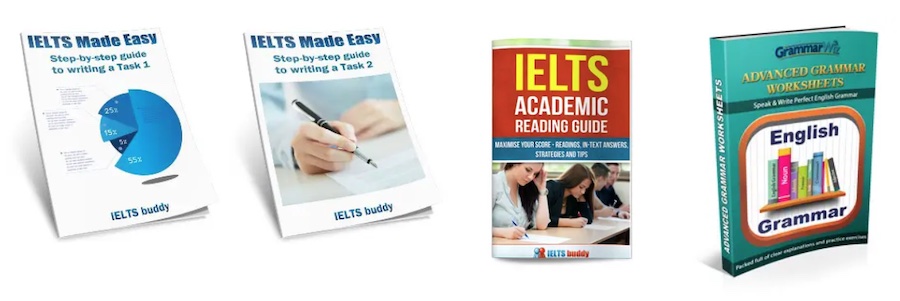
Bargain eBook Deal! 30% Discount
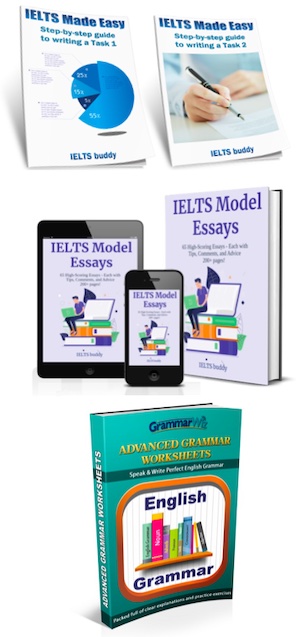
All 4 Writing eBooks for just $25.86 Find out more >>
IELTS Modules:
Other resources:.
- Band Score Calculator
- Writing Feedback
- Speaking Feedback
- Teacher Resources
- Free Downloads
- Recent Essay Exam Questions
- Books for IELTS Prep
- Useful Links

Recent Articles
Improve Coherence and Cohesion in IELTS Writing
Oct 27, 24 07:24 AM
Lesson on Writing IELTS Line Graphs
Oct 15, 24 02:26 AM
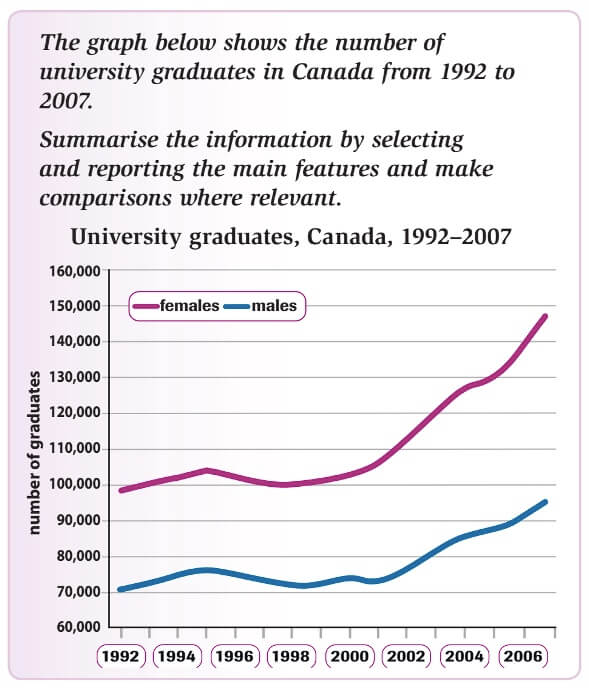
Time Management Tips for IELTS
Oct 06, 24 12:59 PM

Important pages
IELTS Writing IELTS Speaking IELTS Listening IELTS Reading All Lessons Vocabulary Academic Task 1 Academic Task 2 Practice Tests

Connect with us
Before you go...
30% discount - just $25.86 for all 4 writing ebooks.
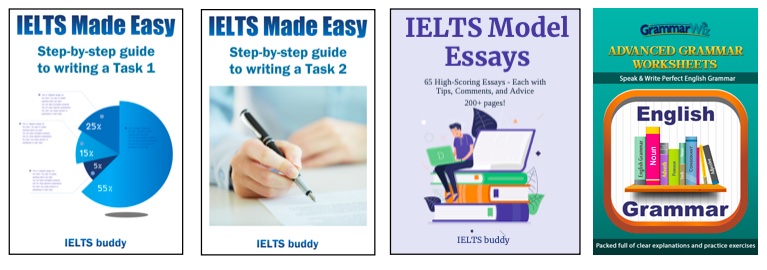
Copyright © 2022- IELTSbuddy All Rights Reserved
IELTS is a registered trademark of University of Cambridge, the British Council, and IDP Education Australia. This site and its owners are not affiliated, approved or endorsed by the University of Cambridge ESOL, the British Council, and IDP Education Australia.
- I nfographics
- Show AWL words
- Subscribe to newsletter
- What is academic writing?
- Academic Style
- What is the writing process?
- Understanding the title
- Brainstorming
- Researching
- First draft
- Proofreading
- Report writing
- Compare & contrast
- Cause & effect
- Problem-solution
- Classification
- Essay structure
- Introduction
- Literature review
- Book review
- Research proposal
- Thesis/dissertation
What is cohesion?
- Cohesion vs coherence
Transition signals
- What are references?
- In-text citations
- Reference sections
- Reporting verbs
- Band descriptors
Show AWL words on this page.
Levels 1-5: grey Levels 6-10: orange
Show sorted lists of these words.
Any words you don't know? Look them up in the website's built-in dictionary .
Choose a dictionary . Wordnet OPTED both
Cohesion How to make texts stick together
Cohesion and coherence are important features of academic writing. They are one of the features tested in exams of academic English, including the IELTS test and the TOEFL test . This page gives information on what cohesion is and how to achieve good cohesion. It also explains the difference between cohesion and coherence , and how to achieve good coherence. There is also an example essay to highlight the main features of cohesion mentioned in this section, as well as some exercises to help you practise.
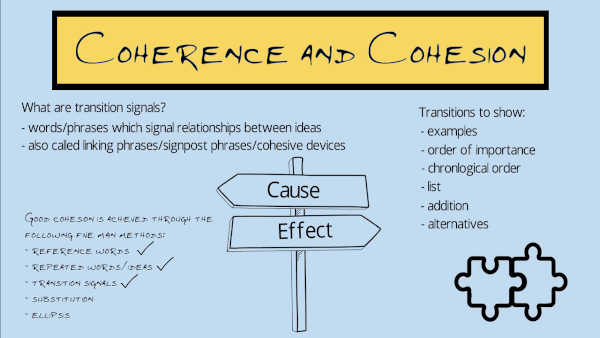
For another look at the same content, check out YouTube or Youku , or the infographic .
It is important for the parts of a written text to be connected together. Another word for this is cohesion . This word comes from the verb cohere , which means 'to stick together'. Cohesion is therefore related to ensuring that the words and sentences you use stick together.
Good cohesion is achieved through the following five main methods, each of which is described in more detail below:
- repeated words/ideas
- reference words
- transition signals
- substitution
Two other ways in which cohesion is achieved in a text, which are covered less frequently in academic English courses, are shell nouns and thematic development . These are also considered below.
Repeated words/ideas
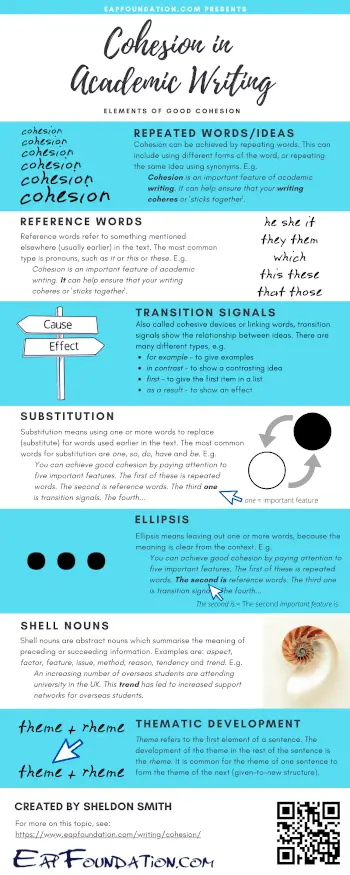
Check out the cohesion infographic »
One way to achieve cohesion is to repeat words, or to repeat ideas using different words (synonyms). Study the following example. Repeated words (or synonyms) are shown in bold.
Cohesion is an important feature of academic writing . It can help ensure that your writing coheres or 'sticks together', which will make it easier for the reader to follow the main ideas in your essay or report . You can achieve good cohesion by paying attention to five important features . The first of these is repeated words. The second key feature is reference words. The third one is transition signals. The fourth is substitution. The final important aspect is ellipsis.
In this example, the word cohesion is used several times, including as a verb ( coheres ). It is important, in academic writing, to avoid too much repetition, so using different word forms or synonyms is common. The word writing is also used several times, including the phrase essay or report , which is a synonym for writing . The words important features are also repeated, again using synonyms: key feature , important aspect .
Reference words
Reference words are words which are used to refer to something which is mentioned elsewhere in the text, usually in a preceding sentence. The most common type is pronouns, such as 'it' or 'this' or 'these'. Study the previous example again. This time, the reference words are shown in bold.
Cohesion is an important feature of academic writing. It can help ensure that your writing coheres or 'sticks together', which will make it easier for the reader to follow the main ideas in your essay or report. You can achieve good cohesion by paying attention to five important features. The first of these is repeated words. The second key feature is reference words. The third one is transition signals. The fourth is substitution. The final important aspect is ellipsis.
The words it , which and these are reference words. The first two of these, it and which , both refer to 'cohesion' used in the preceding sentence. The final example, these , refers to 'important features', again used in the sentence that precedes it.
Transition signals, also called cohesive devices or linking words, are words or phrases which show the relationship between ideas. There are many different types, the most common of which are explained in the next section on transition signals . Some examples of transition signals are:
- for example - used to give examples
- in contrast - used to show a contrasting or opposite idea
- first - used to show the first item in a list
- as a result - used to show a result or effect
Study the previous example again. This time, the transition signals are shown in bold. Here the transition signals simply give a list, relating to the five important features: first , second , third , fourth , and final .
Substitution
Substitution means using one or more words to replace (substitute) for one or more words used earlier in the text. Grammatically, it is similar to reference words, the main difference being that substitution is usually limited to the clause which follows the word(s) being substituted, whereas reference words can refer to something far back in the text. The most common words used for substitution are one , so , and auxiliary verbs such as do, have and be . The following is an example.
- Drinking alcohol before driving is illegal in many countries, since doing so can seriously impair one's ability to drive safely.
In this sentence, the phrase 'doing so' substitutes for the phrase 'drinking alcohol before driving' which appears at the beginning of the sentence.
Below is the example used throughout this section. There is just one example of substitution: the word one , which substitutes for the phrase 'important features'.
Ellipsis means leaving out one or more words, because the meaning is clear from the context. Ellipsis is sometimes called substitution by zero , since essentially one or more words are substituted with no word taking their place.
Below is the example passage again. There is one example of ellipsis: the phrase 'The fourth is', which means 'The fourth [important feature] is', so the words 'important feature' have been omitted.
Shell nouns
Shell nouns are abstract nouns which summarise the meaning of preceding or succeeding information. This summarising helps to generate cohesion. Shell nouns may also be called carrier nouns , signalling nouns , or anaphoric nouns . Examples are: approach, aspect, category, challenge, change, characteristics, class, difficulty, effect, event, fact, factor, feature, form, issue, manner, method, problem, process, purpose, reason, result, stage, subject, system, task, tendency, trend, and type . They are often used with pronouns 'this', 'these', 'that' or 'those', or with the definite article 'the'. For example:
- Virus transmission can be reduced via frequent washing of hands, use of face masks, and isolation of infected individuals. These methods , however, are not completely effective and transmission may still occur, especially among health workers who have close contact with infected individuals.
- An increasing number of overseas students are attending university in the UK. This trend has led to increased support networks for overseas students.
In the example passage used throughout this section, the word features serves as a shell noun, summarising the information later in the passage.
Cohesion is an important feature of academic writing. It can help ensure that your writing coheres or 'sticks together', which will make it easier for the reader to follow the main ideas in your essay or report. You can achieve good cohesion by paying attention to five important features . The first of these is repeated words. The second key feature is reference words. The third one is transition signals. The fourth is substitution. The final important aspect is ellipsis.
Thematic development
Cohesion can also be achieved by thematic development. The term theme refers to the first element of a sentence or clause. The development of the theme in the rest of the sentence is called the rheme . It is common for the rheme of one sentence to form the theme of the next sentence; this type of organisation is often referred to as given-to-new structure, and helps to make writing cohere.
Consider the following short passage, which is an extension of the first example above.
- Virus transmission can be reduced via frequent washing of hands, use of face masks, and isolation of infected individuals. These methods, however, are not completely effective and transmission may still occur, especially among health workers who have close contact with infected individuals. It is important for such health workers to pay particular attention to transmission methods and undergo regular screening.
Here we have the following pattern:
- Virus transmission [ theme ]
- can be reduced via frequent washing of hands, use of face masks, and isolation of infected individuals [ rheme ]
- These methods [ theme = rheme of preceding sentence ]
- are not completely effective and transmission may still occur, especially among health workers who have close contact with infected individuals [ rheme ]
- health workers [ theme, contained in rheme of preceding sentence ]
- [need to] to pay particular attention to transmission methods and undergo regular screening [ rheme ]
Cohesion vs. coherence
The words 'cohesion' and 'coherence' are often used together with a similar meaning, which relates to how a text joins together to make a unified whole. Although they are similar, they are not the same. Cohesion relates to the micro level of the text, i.e. the words and sentences and how they join together. Coherence , in contrast, relates to the organisation and connection of ideas and whether they can be understood by the reader, and as such is concerned with the macro level features of a text, such as topic sentences , thesis statement , the summary in the concluding paragraph (dealt with in the essay structure section), and other 'bigger' features including headings such as those used in reports .
Coherence can be improved by using an outline before writing (or a reverse outline , which is an outline written after the writing is finished), to check that the ideas are logical and well organised. Asking a peer to check the writing to see if it makes sense, i.e. peer feedback , is another way to help improve coherence in your writing.
Example essay
Below is an example essay. It is the one used in the persuasion essay section. Click on the different areas (in the shaded boxes to the right) to highlight the different cohesive aspects in this essay, i.e. repeated words/ideas, reference words, transition signals, substitution and ellipsis.
Title: Consider whether human activity has made the world a better place.
History shows that human beings have come a long way from where they started. They have developed new technologies which means that everybody can enjoy luxuries they never previously imagined. However , the technologies that are temporarily making this world a better place to live could well prove to be an ultimate disaster due to , among other things, the creation of nuclear weapons , increasing pollution , and loss of animal species . The biggest threat to the earth caused by modern human activity comes from the creation of nuclear weapons . Although it cannot be denied that countries have to defend themselves, the kind of weapons that some of them currently possess are far in excess of what is needed for defence . If these [nuclear] weapons were used, they could lead to the destruction of the entire planet . Another harm caused by human activity to this earth is pollution . People have become reliant on modern technology, which can have adverse effects on the environment . For example , reliance on cars causes air and noise pollution . Even seemingly innocent devices, such as computers and mobile phones, use electricity, most of which is produced from coal-burning power stations, which further adds to environmental pollution . If we do not curb our direct and indirect use of fossil fuels, the harm to the environment may be catastrophic. Animals are an important feature of this earth and the past decades have witnessed the extinction of a considerable number of animal species . This is the consequence of human encroachment on wildlife habitats, for example deforestation to expand cities. Some may argue that such loss of [animal] species is natural and has occurred throughout earth's history. However , the current rate of [animal] species loss far exceeds normal levels [of animal species loss] , and is threatening to become a mass extinction event. In summary , there is no doubt that current human activities such as the creation of nuclear weapons , pollution , and destruction of wildlife , are harmful to the earth . It is important for us to see not only the short-term effects of our actions, but their long-term ones as well. Otherwise , human activities will be just another step towards destruction .
Aktas, R.N. and Cortes, V. (2008), 'Shell nouns as cohesive devices in published and ESL student writing', Journal of English for Academic Purposes , 7 (2008) 3-14.
Alexander, O., Argent, S. and Spencer, J. (2008) EAP Essentials: A teacher's guide to principles and practice . Reading: Garnet Publishing Ltd.
Gray, B. (2010) 'On the use of demonstrative pronouns and determiners as cohesive devices: A focus on sentence-initial this/these in academic prose', Journal of English for Academic Purposes , 9 (2010) 167-183.
Halliday, M. A. K., and Hasan, R. (1976). Cohesion in English . London: Longman.
Hinkel, E. (2004). Teaching Academic ESL Writing: Practical Techniques in Vocabulary and Grammar . Mahwah: Lawrence Erlbaum Associates Inc Publishers.
Hyland, K. (2006) English for Academic Purposes: An advanced resource book . Abingdon: Routledge.
Thornbury, S. (2005) Beyond the Sentence: Introducing discourse analysis . Oxford: Macmillan Education.

GET FREE EBOOK
Like the website? Try the books. Enter your email to receive a free sample from Academic Writing Genres .
Below is a checklist for essay cohesion and coherence. Use it to check your own writing, or get a peer (another student) to help you.
Next section
Find out more about transition signals in the next section.
- Transitions
Previous section
Go back to the previous section about paraphrasing .
- Paraphrasing
Exercises & Activities Some ways to practise this area of EAP
You need to login to view the exercises. If you do not already have an account, you can register for free.
- Register
- Forgot password
- Resend activiation email

Author: Sheldon Smith ‖ Last modified: 03 February 2022.
Sheldon Smith is the founder and editor of EAPFoundation.com. He has been teaching English for Academic Purposes since 2004. Find out more about him in the about section and connect with him on Twitter , Facebook and LinkedIn .
Compare & contrast essays examine the similarities of two or more objects, and the differences.
Cause & effect essays consider the reasons (or causes) for something, then discuss the results (or effects).
Discussion essays require you to examine both sides of a situation and to conclude by saying which side you favour.
Problem-solution essays are a sub-type of SPSE essays (Situation, Problem, Solution, Evaluation).
Transition signals are useful in achieving good cohesion and coherence in your writing.
Reporting verbs are used to link your in-text citations to the information cited.
Cohesion And Coherence In Essay Writing
Table of contents, introduction, definitions cohesion and coherence, what is coherence, what is cohesion, how to achieve cohesion and coherence in essay writing, lexical cohesion, grammatical cohesion, substitutions, conjunctions transition words, cohesive but not coherent texts.
The player threw the ball toward the goalkeeper. Balls are used in many sports. Most balls are spheres, but American football is an ellipsoid. Fortunately, the goalkeeper jumped to catch the ball. The crossbar in the soccer game is made of iron. The goalkeeper was standing there.
How to write a coherent essay?
1. start with an outline, 2. structure your essay, 3. structure your paragraphs, 4. relevance to the main topic, 5. stick to the purpose of the type of essay you’re-writing, 6. use cohesive devices and signposting phrases, what is signposting in writing, essay signposting phrases, 7. draft, revise, and edit.
Pasco-Hernando State College
- Unity and Coherence in Essays
- The Writing Process
- Paragraphs and Essays
- Proving the Thesis/Critical Thinking
- Appropriate Language
Test Yourself
- Essay Organization Quiz
- Sample Essay - Fairies
- Sample Essay - Modern Technology
Related Pages
- Proving the Thesis
Unity is the idea that all parts of the writing work to achieve the same goal: proving the thesis. Just as the content of a paragraph should focus on a topic sentence, the content of an essay must focus on the thesis. The introduction paragraph introduces the thesis, the body paragraphs each have a proof point (topic sentence) with content that proves the thesis, and the concluding paragraph sums up the proof and restates the thesis. Extraneous information in any part of the essay that is not related to the thesis is distracting and takes away from the strength of proving the thesis.
An essay must have coherence. The sentences must flow smoothly and logically from one to the next as they support the purpose of each paragraph in proving the thesis.
Just as the last sentence in a paragraph must connect back to the topic sentence of the paragraph, the last paragraph of the essay should connect back to the thesis by reviewing the proof and restating the thesis.
Example of Essay with Problems of Unity and Coherence
Here is an example of a brief essay that includes a paragraph that does not support the thesis “Many people are changing their diets to be healthier.”
People are concerned about pesticides, steroids, and antibiotics in the food they eat. Many now shop for organic foods since they don’t have the pesticides used in conventionally grown food. Meat from chicken and cows that are not given steroids or antibiotics are gaining popularity even though they are much more expensive. More and more, people are eliminating pesticides, steroids, and antibiotics from their diets. Eating healthier also is beneficial to the environment since there are less pesticides poisoning the earth. Pesticides getting into the waterways is creating a problem with drinking water. Historically, safe drinking water has been a problem. It is believed the Ancient Egyptians drank beer since the water was not safe to drink. Brewing beer killed the harmful organisms and bacteria in the water from the Nile. There is a growing concern about eating genetically modified foods, and people are opting for non-GMO diets. Some people say there are more allergic reactions and other health problems resulting from these foods. Others are concerned because there are no long-term studies that clearly show no adverse health effects such as cancers or other illnesses. Avoiding GMO food is another way people are eating healthier food.
See how just one paragraph can take away from the effectiveness of the essay in showing how people are changing to healthier food since unity and coherence are affected. There is no longer unity among all the paragraphs. The thought pattern is disjointed and the essay loses its coherence.
Transitions and Logical Flow of Ideas
Transitions are words, groups of words, or sentences that connect one sentence to another or one paragraph to another.
They promote a logical flow from one idea to the next and overall unity and coherence.
While transitions are not needed in every sentence or at the end of every paragraph, they are missed when they are omitted since the flow of thoughts becomes disjointed or even confusing.
There are different types of transitions:
- Time – before, after, during, in the meantime, nowadays
- Space – over, around, under
- Examples – for instance, one example is
- Comparison – on the other hand, the opposing view
- Consequence – as a result, subsequently
These are just a few examples. The idea is to paint a clear, logical connection between sentences and between paragraphs.
- Printer-friendly version

Achieving coherence
“A piece of writing is coherent when it elicits the response: ‘I follow you. I see what you mean.’ It is incoherent when it elicits the response: ‘I see what you're saying here, but what has it got to do with the topic at hand or with what you just told me above?’ ” - Johns, A.M
Transitions
Parallelism, challenge task, what is coherence.
Coherence in a piece of writing means that the reader can easily understand it. Coherence is about making everything flow smoothly. The reader can see that everything is logically arranged and connected, and relevance to the central focus of the essay is maintained throughout.

Repetition in a piece of writing does not always demonstrate cohesion. Study these sentences:
So, how does repetition as a cohesive device work?
When a pronoun is used, sometimes what the pronoun refers to (ie, the referent) is not always clear. Clarity is achieved by repeating a key noun or synonym . Repetition is a cohesive device used deliberately to improve coherence in a text.
In the following text, decide ifthe referent for the pronoun it is clear. Otherwise, replace it with the key noun English where clarity is needed.
Click here to view the revised text.
Suggested improvement
English has almost become an international language. Except for Chinese, more people speak it (clear reference; retain) than any other language. Spanish is the official language of more countries in the world, but more countries have English ( it is replaced with a key noun) as their official or unofficial second language. More than 70% of the world's mail is written in English ( it is replaced with a key noun). It (clear reference; retain) is the primary language on the Internet.
Sometimes, repetition of a key noun is preferred even when the reference is clear. In the following text, it is clear that it refers to the key noun gold , but when used throughout the text, the style becomes monotonous.
Improved text: Note where the key noun gold is repeated. The deliberate repetition creates interest and adds maturity to the writing style.
Gold , a precious metal, is prized for two important characteristics. First of all, gold has a lustrous beauty that is resistant to corrosion. Therefore, it is suitable for jewellery, coins and ornamental purposes. Gold never needs to be polished and will remain beautiful forever. For example, a Macedonian coin remains as untarnished today as the day it was made 23 centuries ago. Another important characteristic of gold is its usefulness to industry and science. For many years, it has been used in hundreds of industrial applications. The most recent use of gold is in astronauts’ suits. Astronauts wear gold -plated shields when they go outside spaceships in space. In conclusion, gold is treasured not only for its beauty but also its utility.
Pronoun + Repetition of key noun
Sometimes, greater cohesion can be achieved by using a pronoun followed by an appropriate key noun or synonym (a word with a similar meaning).
Transitions are like traffic signals. They guide the reader from one idea to the next. They signal a range of relationships between sentences, such as comparison, contrast, example and result. Click here for a more comprehensive list of Transitions (Logical Organisers) .
Test yourself: How well do you understand transitions?
Which of the three alternatives should follow the transition or logical organiser in capital letters to complete the second sentence?
Using transitions/logical organisers
Improve the coherence of the following paragraph by adding transitions in the blank spaces. Use the italicised hint in brackets to help you choose an apporpriate transition for each blank. If you need to, review the list of Transitions (Logical Organisers) before you start.
Using transitions
Choose the most appropriate transition from the options given to complete the article:
Overusing transitions
While the use of appropriate transitions can improve coherence (as the previous practice activity shows), it can also be counterproductive if transitions are overused. Use transitions carefully to enhance and clarify the logical connection between ideas in extended texts. Write a range of sentences and vary sentence openings.
Study the following examples:
Identifying cohesive devices


IMAGES
VIDEO
COMMENTS
Coherence refers to a style of writing where ideas, themes, and language connect logically, consistently, and clearly to guide the reader's understanding.
Summing Up. Improving coherence and cohesion in IELTS writing takes time and a lot of practice. Start by writing short essays and reviewing how well your ideas flow from one sentence and paragraph to the next. You can …
Cohesion and coherence are important features of academic writing. They are one of the features tested in exams of academic English, including the IELTS test and the TOEFL test. This page gives information on …
To achieve coherence in an essay, writers use lexical and grammatical cohesive devices. Examples of these cohesive devices are repetition, synonymy, antonymy, meronymy, substitutions, and anaphoric or cataphoric …
Coherence. An essay must have coherence. The sentences must flow smoothly and logically from one to the next as they support the purpose of each paragraph in proving the thesis.
Cohesion and Coherence. A well-organized paper uses techniques to build cohesion and coherence between and within paragraphs to guide the reader through the paper by …
Coherence in a piece of writing means that the reader can easily understand it. Coherence is about making everything flow smoothly. The reader can see that everything is logically arranged and connected, and relevance to the central …
Coherent writing moves smoothly between ideas. It guides the reader through an argument or series of points using signposts and connectors. It generally has a clear structure and …
Coherence is concerned with how a writer guides the reader through the argument using logical connectors. It can be achieved by using signposting phrases.
overriding logic is not yet fully formed. But creating coherence takes more than supplying the standard transitional language to link thoughts. Coherence is built into the paper from the …